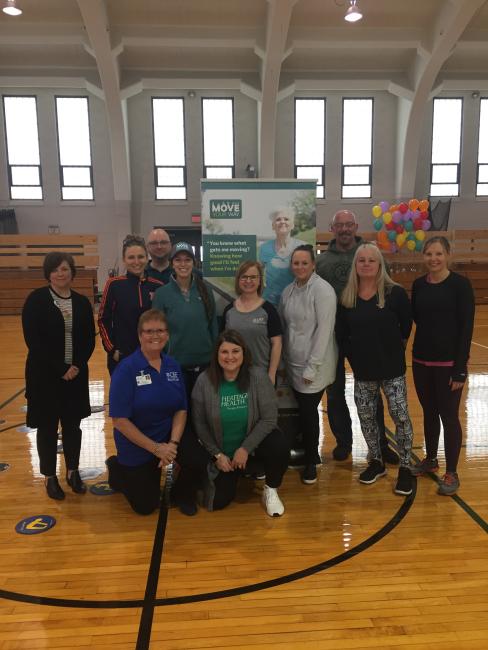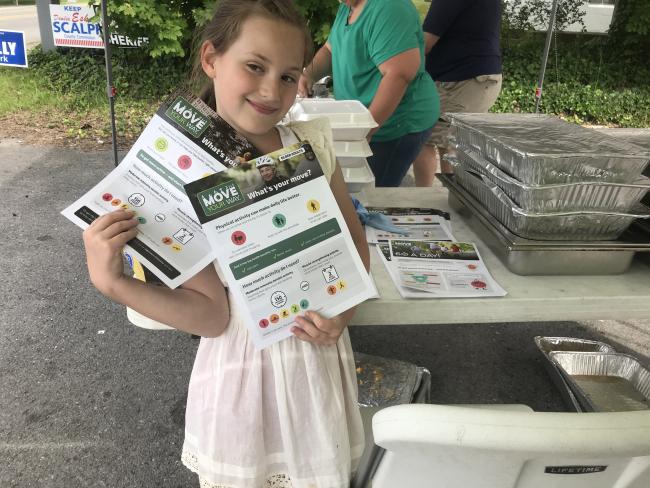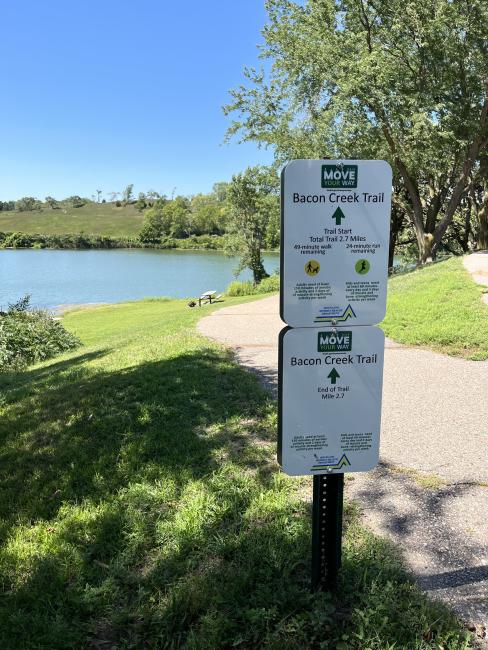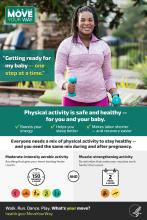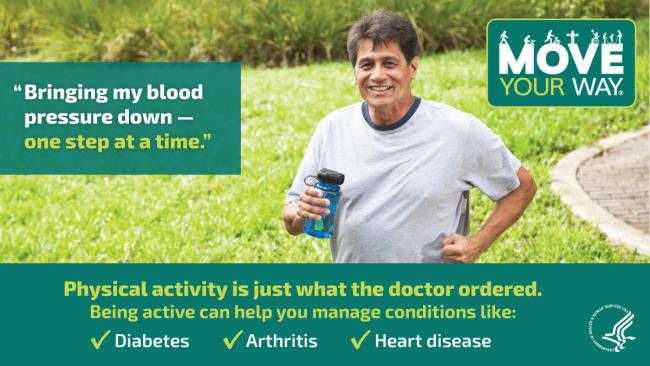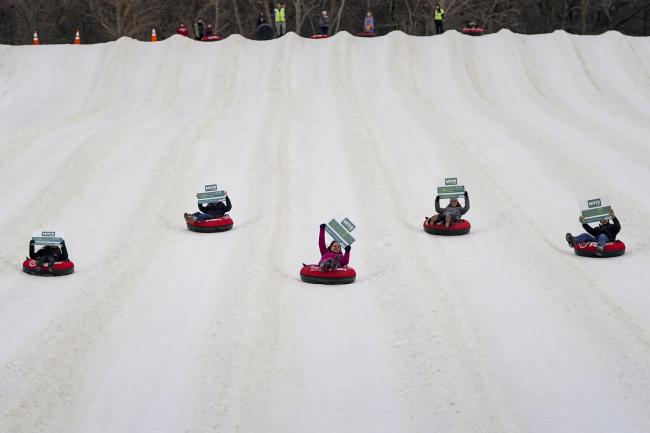In this section of the playbook, you’ll learn how to plan and launch a physical activity campaign. But keep in mind that you can adapt many of the tips to match your unique needs and approach. For example, build your team has information about working with partners to get people in your community moving, whether it’s through a campaign or individual activities and events.
Ready to bring Move Your Way® to your community? First, identify your campaign team and lead organization.
- The campaign team is the core group of people who will guide your local Move Your Way® campaign activities and initiatives from planning through implementation.
- The lead organization — usually a government public health office or an organization related to physical activity or health and wellness — is the institutional home of the community campaign.
Working solo or without a lead organization? No problem — you can adapt the tips and resources in the playbook to build a campaign on the scale that works for you.
Now it’s time to map out your strategies for success. Plan to spend 3 to 5 months in the planning and strategy development phase.
During this phase, the campaign team is responsible for planning the campaign, delegating tasks, and securing funding and other support. Phase 2: Implementation & Evaluation will include overseeing events, disseminating materials, coordinating with committees and partners, and evaluating campaign activities.
Get familiar with Move Your Way
Before you start planning, get to know all the Move Your Way Campaign Materials. Move Your Way is the promotional campaign for the second edition of the Physical Activity Guidelines for Americans.
The Physical Activity Guidelines provides recommendations about the amount and types of activity adults and children need to stay healthy. And the Move Your Way campaign provides fact sheets, posters, videos, and interactive tools to help turn those recommendations into easy-to-understand physical activity guidance for youth, adults, older adults, people during and after pregnancy, parents, and health professionals.
Move Your Way resources are for all Americans, but we know one size doesn’t fit all. That’s where you come in! Think about the resources that will be most useful for you. Which materials will resonate most with people in your community? Will you need materials in English, Spanish, or both? Start imagining where you can distribute and share materials locally and how Move Your Way can help support existing or new physical activity efforts in your community.
Check out the What is the Move Your Way Campaign? video clip to learn more about the campaign. It’s also a great resource to share with your team and potential partners!
 Tips
Tips
- Take our Move Your Way resources for a test drive! Use the Move Your Way Activity Planner to build your own weekly physical activity plan, or watch the Move Your Way Videos together with your campaign team. It’s much easier to promote materials you’ve used yourself.
- Sign up for health.gov email updates about physical activity — including announcements for new Move Your Way resources!
 Resources
Resources
- Check out the Guiding Models of Move Your Way [PDF - 386.01 KB] to better understand the theory and rationale behind the campaign.
- Review some implementation strategies to learn about different types of events, activities, and programs that can be used to promote the campaign.
Check out Move Your Way pilot communities
Since ODPHP launched the campaign in 2018, 10 communities have launched their own community pilot campaigns. These pilots were led by a variety of public health departments, parks and recreation departments, and nonprofits focused on physical activity and health.
Communities nationwide — no matter their size, location, or budget — can adapt Move Your Way to fit their needs, resources, and opportunities. Check out the following blog posts to learn how organizations across the United States made Move Your Way a success in their communities:
Communities with fewer than 30,000 people
- Streator, Illinois: In 2020, Live Well Streator kicked off their campaign with an in-person event at the Streator Incubator. Participants joined fitness classes, walked briskly around the perimeter of the facility, and received resources about community organizations that support physical activity.
Communities with 30,000 to 200,000 people
- Jackson, Mississippi: In 2019, the Mississippi State Department of Health’s campaign in Jackson, Mississippi, included a social media challenge and a “Try-a-thon” launch event that encouraged people to get active.
- Sioux City, Iowa: The Siouxland District Health Department used in-person activities, social media, and educational signs throughout town during their 2020 campaign. In 2021, Sioux City focused their second Move Your Way campaign on physical activity during and after pregnancy.
- Wyandotte County, Kansas: BikeWalkKC, an active transportation organization in Kansas City, connected Move Your Way messages with a growing interest in safe bicycling during the COVID-19 pandemic.
Communities with 200,000 to 1 million people
- Cabarrus County, North Carolina: In 2020, Cabarrus Health Alliance used Move Your Way messages and resources to support their Walk Cabarrus walking challenge.
- Columbus, Ohio: Move Your Way helped Columbus Public Health develop new and unexpected collaborations during their urban campaign.
- Southern West Virginia: Active Southern West Virginia used both in-person and virtual activities during their 2020 campaign to offer physical activity programs to West Virginians in 6 counties, and they focused on older adults during their 2021 implementation.
Communities with more than 1 million people
- Chicago, Illinois: In 2020, the Chicago Park District encouraged residents to get active at home and in their local parks. Then, in 2021, Chicago implemented another Move Your Way campaign — but this time they focused on encouraging teens to get active.
- Fairfax County, Virginia: Fairfax County Park Authority incorporated Move Your Way into their Healthy Strides virtual fitness classes.
- Southern Nevada: In 2019, the Southern Nevada Health District held a Move Your Way 5K event and worked with schools to reach local families. Then, in 2021, Las Vegas launched another Move Your Way campaign, this one focused on Spanish speakers in the community.
Listen to community pilot partners across the country explain how they successfully used Move Your Way in their communities.
 Tips
Tips
- View this webinar recording to learn about successful strategies a few of these communities used to implement their Move Your Way campaigns.
Set priorities, goals, and metrics
The national Move Your Way campaign aims to help people live healthier lives through physical activity — but you can set unique, place-based goals and priorities for your local community campaign.
To guide strategy development, sit down with your campaign team and decide on:
- Priority populations you want to reach, like Spanish speakers or parents of school-aged children
- Goals you want to work toward, like boosting local youth sports participation
- Objectives to help you reach those goals, like offering free or low-cost youth sports teams at local rec centers
- A time frame for reaching your goals and promoting the campaign
- Metrics you’ll use to measure success, like event attendance, engagement on social media, or new partnerships
You can continue to refine and adjust these goals and priorities throughout the planning phase, but it’s helpful to have guidance in place as you search for partners and coordinate tasks.
 Tips
Tips
- When you’re choosing priority populations, think of groups in your community that are less likely to be meeting the Physical Activity Guidelines and that have fewer services available to them. This will help you maximize your impact.
- Remember to look for opportunities to engage your campaign's priority audience early on in campaign development. Getting your audience involved in the planning and decision-making process will help make your campaign a success!
- Plan ahead for using metrics (like engagement on your social media posts) and gathering data. Check out the Evaluate your challenges and successes section for evaluation tips and resources. Then make a clear plan with your campaign team to track these metrics continuously during your campaign.
 Resources
Resources
- Use the Campaign Implementation Tracker to decide which key metrics you’d like to collect during your campaign, like number of materials distributed.
- If you’re planning to hold a community event, take a look at the Intercept Interview Guide: How to Interview Event Attendees [PDF - 864 KB] to think about feedback you’d like to get from your attendees. You’ll be able to use the feedback you gather to evaluate the campaign later.
- Use the Tips for Developing a Campaign Budget [PDF - 896.3 KB] to help you keep your budget in mind as you develop campaign goals and an evaluation plan.
Brainstorm implementation strategies
There are many ways to use Move Your Way to encourage physical activity — no matter your organization’s size, location, or budget. This list is based on creative ideas from the Move Your Way pilot communities and evidence-based strategies for getting people active. Use it as a starting point to help you brainstorm ways for using Move Your Way in your own community!
Use built environment promotion
The places where people live, work, and play make a big difference when it comes to physical activity levels. When you’re encouraging people to get active, try using these strategies that take their environment into account:
- Point-of-decision prompts: Use Move Your Way messaging on signs that encourage people to choose to be more active. For example, near a stairwell or wheelchair ramp, put a sign that reads: “Adults need at least 150 minutes of physical activity every week. Try taking the stairs or using the ramp instead of the elevator — it all adds up!”
- Wayfinding signage: Incorporate Move Your Way messages and imagery on signage near trails, parks, playgrounds, and busy pedestrian zones to let people know the distance to other nearby locations. For example, next to a trail mile marker, put a sign that says: “Get a little more active each day. Move Your Way.”
- Educational signage: Sometimes people in your community may need help understanding how they can use everyday equipment to be active — and educational signs can help with this. For example, consider putting a sign near playground benches that reads: “Adults need physical activity, too — and lots of things count!” and has images and descriptions of activities that involve a bench.
- Public awareness activities: Use Move Your Way to plan a launch event for a new or restored park, trail, or greenway. At the launch event, promote the features of the new infrastructure alongside Move Your Way fact sheets and posters to encourage community members to get active and learn about the benefits of physical activity. Remember to build social media into to your promotional efforts!
Host community events
According to The Community Guide, community events are an important piece of community-wide campaigns to promote physical activity and get people moving. Try using these strategies when you’re hosting or participating in events that encourage people to get active:
- Host Move Your Way-themed events: Move Your Way pilot communities have hosted a variety of Move Your Way events, like family 5Ks and winter festivals with activity ideas for colder months.
- Join other community events: Think about how you might build a Move Your Way presence at existing community events! You could organize an activity break during a summer concert series, support active transportation events like Bike-to-Work Day, or pass out Move Your Way resources at health fairs. Consider developing a resource list or calendar that highlights local activities and physical activity events.
Advertise in the community and distribute print materials
The Move Your Way campaign works best when people see messages and materials in many places. Distributing print materials and using environmental advertising can promote physical activity outside of events, programming, and online activities. Try using these strategies to get creative with advertising in the community:
- Use environmental advertising: Consider creating Move Your Way educational billboards, bus advertisements, or other place-based ads in your community.
- Collaborate with partners: You don’t have to distribute the materials on your own! Partners play a vital role in the success of community campaigns. Move Your Way community pilots have worked alongside schools, parks and recreation departments, Safe Routes to School programs, bicycling organizations, libraries, Scouts, chambers of commerce, Kiwanis, community colleges, universities, cooperative extensions, community health coalitions, and more.
- Meet people where they are: Brainstorm where people in your community gather. Maybe it’s the local diner, library, or park. See if your local food bank can hand out fact sheets as part of their food distribution — or if nearby vaccine clinics can distribute Move Your Way resources with their follow-up materials.
Get creative with physical activity programming
You can also include Move Your Way in physical activity programming in your community. Community pilot organizations added Move Your Way messaging, education, and materials into walking challenges, free and low-cost fitness classes, kids run clubs, walking groups, and worksite wellness initiatives.
Use point-of-care prompts
Research shows that health care providers play an important role in promoting physical activity within their community. Try partnering with local health care providers and encouraging them to talk with their patients about the importance of getting more active.
Health care facilities can also promote physical activity by displaying Move Your Way posters in waiting rooms and hallways, distributing fact sheets during patient visits, and playing Move Your Way videos on office televisions.
Harness public affairs activities
Get the word out about physical activity and the Move Your Way campaign through public affairs activities like interviews on local TV broadcasts, coverage in the local paper or an online newsletter, and mentions by radio hosts.
Promote Move Your Way online and through social media
Social media and other online promotion can be a major element of spreading the word about Move Your Way! Take advantage of Move Your Way’s social media messages and graphics to promote physical activity across platforms. Some Move Your Way pilot communities have taken social media a step further and held challenges encouraging followers to share photos and videos of how they move — and to include the hashtag #MoveYourWay.
Host virtual events and other programming
Promoting physical activity during the COVID-19 pandemic meant a shift to virtual events and programming for communities across the United States. But virtual events don’t have to be limited to pandemic times — they can be a great way to engage community members who might not make it to in-person activities!
For example, many Move Your Way community pilots held virtual launch events. Other community pilots offered Move Your Way-themed virtual fitness classes — which are a great way to provide physical activity opportunities to people in their homes!
 Tips
Tips
- Take a look at how previous pilot communities have hosted Move Your Way-themed events, like family 5Ks and “Try-a-Thons", events with a variety of physical activities, and a winter festival showcasing fun activities for the colder months.
- Try asking your local TV or radio station to conduct interviews with community members on local TV broadcasts, or look into getting coverage about your campaign in the local paper.
- Read about how previous Move Your Way pilot communities got creative during COVID-19 with virtual programming — including a virtual campaign kickoff that featured a walking challenge and an event connecting residents with virtual fitness classes.
 Resources
Resources
- Check out the Active People, Healthy NationSM initiative from the Centers for Disease Control and Prevention (CDC)’s Strategies to Increase Physical Activity and the Community Preventive Services Task Force’s Guide to Community Preventive Services (The Community Guide) for additional strategies to improve physical activity.
- If you’re partnering with health care providers, point them to the Move Your Way resources specifically for them so they can get tips for talking with patients about how to get enough physical activity.
- Try linking to the Move Your Way microsite, activity planner, or interactive graphic from your website or e-newsletters. Or you can easily add the Move Your Way web badges and widgets to your organization’s website.
- Check out existing social media messages and graphics to promote your campaign on social media. You can swap out photos on materials or add your organization’s logo through the CDC State and Community Health Media Center. If you have questions about using Move Your Way materials or want to create your own, please contact us.
- We’re here to help! Reach out to us with any questions about implementing Move Your Way in your community.
Delegate key tasks
Based on input from our pilot communities, ODPHP recommends delegating tasks in the following key areas to prepare for the campaign:
- Partnerships — engaging with influential local organizations and leaders to build support and coordinate physical activity efforts
- Media — setting strategy for using social media and other channels to spread the word about your campaign
- Events — planning your launch and other community events to engage local audiences and get people moving
- Materials — selecting, customizing, and distributing Move Your Way materials to promote campaign events and initiatives
But remember, every community is different! Organize and delegate your tasks however works best for you. If you’re working solo, choose priority tasks to lead yourself and ask partner organizations to take the lead on others. If you have lots of people pitching in, you can form committees to tackle each key area — just make sure to coordinate efforts.
 Tips
Tips
- To help decide on key tasks or recruit people to serve on committees, hold a community roundtable event. Invite local public health professionals and community members from various fields and ask for their input.
- Create a shared calendar to plan and track committee meetings and other campaign events and activities.
 Resources
Resources
- Use or adapt our Recruitment Email to ask people to join your campaign efforts and work on different priority tasks.
- Follow the Campaign Launch Task List [PDF - 947.74 KB] to guide priority tasks in the months before and after the launch event. If you don’t have committees, delegate priority tasks to members of your campaign team.
- Check out our Tips for Coordinating Social Media Promotion [PDF - 444.74 KB] to help your team members and external partners easily spread the word about your campaign.
Build your team
Think about ways to collaborate with partners in your community. Which local organizations have similar goals? How can you use Move Your Way to work with them?
Make lists of potential partners, including:
- Traditional partners, like schools, worksite wellness programs, and community-based organizations related to physical activity
- Non-traditional partners, like police departments, local chambers of commerce, and religious organizations
- Organizations that work on related issues, like preventing chronic diseases or building walkable neighborhoods
- Influential community members who can serve as local champions for the campaign
If you already have a coalition of local partners, work to strengthen it by adding new partners and increasing engagement with members of your existing coalition.
Then do some legwork to choose the most promising opportunities:
- Designate a point person to reach out to key contacts.
- Attend upcoming community meetings and events to network and talk about potential collaborations.
- Regroup with your campaign team to decide which new partnerships to pursue.
 Tips
Tips
- Start by contacting people you know. Networking is key to successful community campaigns, so reach out to your contacts in local government, nonprofits, and private business who may be willing to get involved with Move Your Way.
- Get creative and consider partnerships with organizations that can help you plan and execute Move Your Way community events — like vendors, venues, or service clubs.
- The connections you’re making through Move Your Way could last a lifetime — but only if you maintain them. Remember to send thank you notes to your partners to let them know how much you appreciate their support.
 Resources
Resources
- Share this Get to Know the Move Your Way Campaign video with your team and potential partners to introduce them to the campaign, Move Your Way materials, and the playbook.
- Follow the partnership tasks in the Campaign Launch Task List [PDF - 947.74 KB] to stay on track as you collaborate and coordinate with other organizations.
- Use our Partnership Tip Sheets to work effectively with community-based organizations, schools, and worksite wellness programs.
- Use these Campaign Talking Points [PDF - 809 KB] to help you pitch Move Your Way to potential partners.
- Check out how pilot communities worked with new partners and existing partners to promote their campaigns.
Secure funding and volunteers
Planning and implementing a Move Your Way community campaign is a big undertaking, and you’ll need sufficient funding and volunteer support to pull it off. But when people hear about the great work you’re doing, they’ll be happy to help!
Decide what you need to be successful and start asking for it:
- Create a budget that includes costs for event venues, supplies, vendors, printing, advertising, and campaign team salaries.
- Apply for grants from government public health agencies and nonprofits at the national, state, or local level. Check out the resources below for sample grant language.
- Ask local businesses to donate or lend items for events, like event space, food, sports equipment, and prizes for giveaways.
- Recruit volunteers to help with campaign activities, like taking photos or registering attendees at the launch event.
 Tips
Tips
- Ask local colleges if their students need volunteer opportunities. Student volunteers can help run events. They may also be able to contribute skills like video production and graphic design.
- When you ask for donations, explain how they’ll be used. Paint a picture of the event or material and how it will impact real people in your community. People are more likely to donate if they can picture what they’re funding.
- If you’re approaching existing donors, frame the campaign as an exciting new project — and a reason to renew their support.
- Offer to add donor logos to your campaign materials in exchange for donations.
- Ask everyone involved in your campaign to help out with networking — personal contacts are more likely to donate time and money. Encourage them to reach out in person and on social media.
 Resources
Resources
- Use or adapt the Sample Pitch Language [PDF - 281.96 KB] to make your case to prospective donors.
- Find sample language for grant applications in Guiding Models of Move Your Way [PDF - 386.01 KB].
- Use the Tips for Developing a Campaign Budget [PDF - 896.34 KB] to help you figure out which campaign activities to prioritize based on your budget.
Plan a launch event
Your launch event introduces your campaign to the whole community. Plan an event that will raise awareness about Move Your Way and get people excited about physical activity.
(Keep in mind that you can still use the tips in this section if you’re not launching a campaign but want to plan events promoting physical activity in your community. You can also check out these tips and resources for hosting community events!)
Brainstorm ideas for your launch event, including:
- Local venues, like parks, rec centers, or schools
- Must-haves for your location, like convenient public transportation
- Speakers and special guests to help lead activities, like local athletes or elected officials
- Event activities, like a bike ride or an obstacle course
- Vendors who can provide other services, like face painting or nutrition counseling
- Ways to use campaign materials, like handing out fact sheets to attendees
- Ways to promote the event, like social media or radio ads
Decide on a launch event plan with your campaign team. Then delegate tasks like sending invitations, confirming speakers, and booking a venue — and make sure to set deadlines so everything stays on track.
 Tips
Tips
- Be sure to engage with your campaign audience when you're planning your launch event. Find out what types of activities and events they're interested in attending.
- Make your event accessible. Choose a venue that’s welcoming for people with disabilities and families with kids of all ages.
- Offer lower-intensity activity options — like a 1K walk alongside a 5K run — to be more welcoming to kids, older adults, or anyone just starting to get active.
- Plan for the weather. If you’re launching in summer, consider hosting some or all of the event in an air-conditioned space. If your event is outdoors, choose a rain date. You can even launch virtually or with winter-specific activities.
- Mix it up! Offer a range of activities to help people find things they really enjoy. Consider fun group activities like Zumba and line dancing, and choose things that work for people with diverse abilities.
 Resources
Resources
- Follow the event tasks in the Campaign Launch Task List [PDF - 947.74 KB] to stay on track as you plan your launch event.
- Use these Tips for Coordinating Social Media Promotion [PDF - 444.74 KB] to help you promote your campaign launch event.
- Check out the Brainstorm Implementation Strategies section for more launch event ideas.
Move Your Way® and the Move Your Way logo are registered service marks of the U.S. Department of Health and Human Services. HHS encourages organizations and individuals to download, print, and distribute Move Your Way materials. You can swap out photos or add your organization’s logo through the CDC State and Community Health Media Center. If you have questions about using Move Your Way materials or want to create your own, please contact us.
